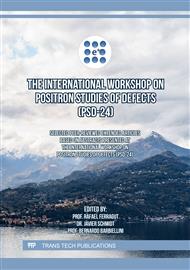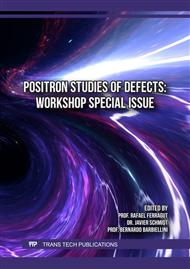[1]
L.D. Barnes, S.J. Gilbert and C.M. Surko: Phys. Rev. A Vol. 67 (2003), 032706.
Google Scholar
[2]
L.D. Barnes, J.A. Young and C.M. Surko: Phys. Rev. A, Vol. 74 (2006), 012706.
Google Scholar
[3]
J.R. Danielson, J.A. Young and C.M. Surko: J. Phys. B: At., Mol. Opt. Phys. Vol. 42 (2009), 235203.
Google Scholar
[4]
A.R. Swann and G.F. Gribakin: J. Chem. Phys., Vol. 153, (2020), 184311.
Google Scholar
[5]
M. Furushima, M. Takagi, D. Yoshida, Y. Kita, T. Shimazaki and M. Tachikawa: Phys. Chem. Chem. Phys., Vol. 25 (2023), p.625.
Google Scholar
[6]
D. Yoshida, Y. Kita, T. Shimazaki and M. Tachikawa. Phys. Chem. Chem. Phys., Vol. 24 (2022), p.26898.
Google Scholar
[7]
O.H. Crawford: Proc. Phys. Soc. Vol. 91 (1967) p.279.
Google Scholar
[8]
K. Koyanagi, Y. Kita and M. Tachikawa: Eur. Phys. J. D Vol. 66 (2012), p.121.
Google Scholar
[9]
M. Nummela, H. Raebiger, D. Yoshida and M. Tachikawa: J. Phys. Chem. A Vol. 120 (2016), p.4037.
Google Scholar
[10]
M. Ozaki, D. Yoshida, Y. Kita, T. Shimazaki and M. Tachikawa: ACS Omega Vol. 6 (2021), p.29449.
DOI: 10.1021/acsomega.1c03409
Google Scholar
[11]
J.A. Charry, J. Romero, M.T. do Nascimento Varella and A. Reyes: Phys. Rev. A: At., Mol., Opt. Phys. Vol. 89 (2014), 052709.
Google Scholar
[12]
Y. Sugiura, T. Takayanagi, Y. Kita and M Tachikawa: Eur. Phys. J. D, Vol. 73 (2019), p.162.[13] Y. Sugiura, H. Suzuki, T. Otomo, T. Miyazaki, T. Takayanagi and M. Tachikawa: J. Comput. Chem. Vol. 41 (2020), p.1576.
DOI: 10.1002/jcc.26200
Google Scholar
[14]
M. Lattelais, F. Pauzat, J. Pilmé, Y. Ellinger and C. Ceccarelli: Astron. Astrophys. Vol. 532 (2011), p.1.
Google Scholar
[15]
V. Barone, M. Biczysko, J. Bloinoac and C. Puzzarini: Astron. Astrophys. Vol. 15 (2013), p.10094.
Google Scholar
[16]
S. Maeda, Y. Harabuchi, Y. Sumiya, M. Takagi, K. Suzuki, M. Hatanaka, Y. Osada, T. Taketsugu, K. Morokuma and K. Ohno: GRRM17. Information on http://iqce.jp/GRRM/index_e.shtml (Accessed 20 Aug 2024).
Google Scholar
[17]
S. Maeda, K. Ohno and K. Morokuma: Phys. Chem. Chem. Phys. Vol. 15 (2013), p.3683.
Google Scholar
[18]
S. Maeda, Y. Harabuchi, M. Takagi, K. Saita, K. Suzuki and T. Ichino: J. Comput. Chem. Vol. 39 (2017), p.233.
Google Scholar
[19]
J.K. O'Connell and N.F. Lane: Phys. Rev. A Vol. 27 (1983),1893.
Google Scholar
[20]
A. Jain: Phys. Rev. A, Vol. 41 (1990), 2437.
Google Scholar
[21]
B. Barbiellini, M.J. Puska, T. Torsti and R.M. Nieminen: Phys. Rev. B Vol. 51 (1995), 7341.
Google Scholar
[22]
E. Boroński and R.M. Nieminen: Phys. Rev. B Vol. 34 (1986), 3820.
Google Scholar
[23]
B. Barbiellini-Amidei: Phys. Lett. A Vol. 134 (1989), p.328.
Google Scholar
[24]
B. Barbiellini, M.J. Puska, T. Torsti and R.M. Nieminen: Phys. Rev. B, Vol. 53 (1996),16201.
Google Scholar
[25]
J. Kuriplach and B. Barbiellini: Phys. Rev. B Vol. 89 (2014), 155111.
Google Scholar
[26]
J.C. Light, I.P. Hamilton and J.V. Lill: J. Chem. Phys. Vol. 82 (1985), p.1400.
Google Scholar
[27]
R. Kosloff and H. Tal-Ezer: Phys. Lett. Vol. 127 (1986), p.223.
Google Scholar
[28]
M.J. Frisch, G.W. Trucks, H.B. Schlegel, G.E. Scuseria, M.A. Robb, J.R. Cheeseman, G. Scalmani, V. Barone, G.A. Petersson, H. Nakatsuji, X. Li, M. Caricato, A.V. Marenich, J. Bloino, B.G. Janesko, R. Gomperts, B. Mennucci, H.P. Hratchian, J.V. Ortiz, A.F. Izmaylov, J.L. Sonnenberg, D. Williams-Young, F. Ding, F. Lipparini, F. Egidi, J. Goings, B. Peng, A. Petrone, T. Henderson, D. Ranasinghe, V.G. Zakrzewski, J. Gao, N. Rega, G. Zheng, W. Liang, M. Hada, M. Ehara, K. Toyota, R. Fukuda, J. Hasegawa, M. Ishida, T. Nakajima, Y. Honda, O. Kitao, H. Nakai, T. Vreven, K. Throssell, J. A. Montgomery, Jr., J. E. Peralta, F. Ogliaro, M.J. Bearpark, J.J. Heyd, E.N. Brothers, K.N. Kudin, V.N. Staroverov, T.A. Keith, R. Kobayashi, J. Normand, K. Raghavachari, A.P. Rendell, J.C. Burant, S.S. Iyengar, J. Tomasi, M. Cossi, J.M. Millam, M. Klene, C. Adamo, R. Cammi, J.W. Ochterski, R.L. Martin, K. Morokuma, O. Farkas, J.B. Foresman and D.J. Fox: Gaussian 16 Revision C.01, 2016. Gaussian Inc. Wallingford CT.
Google Scholar



